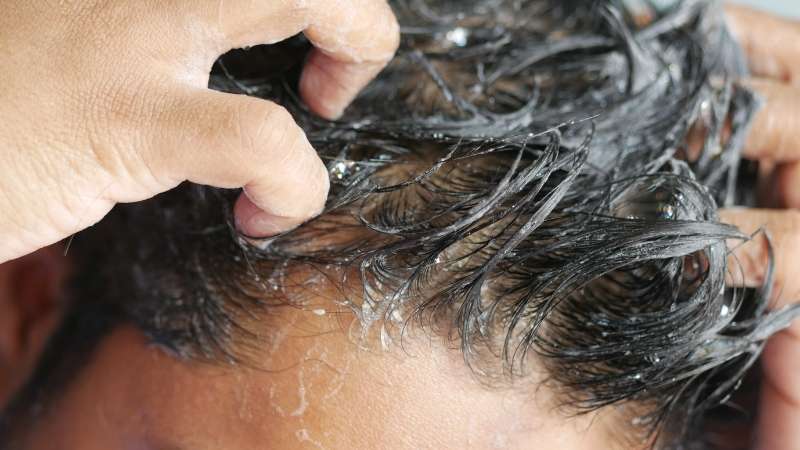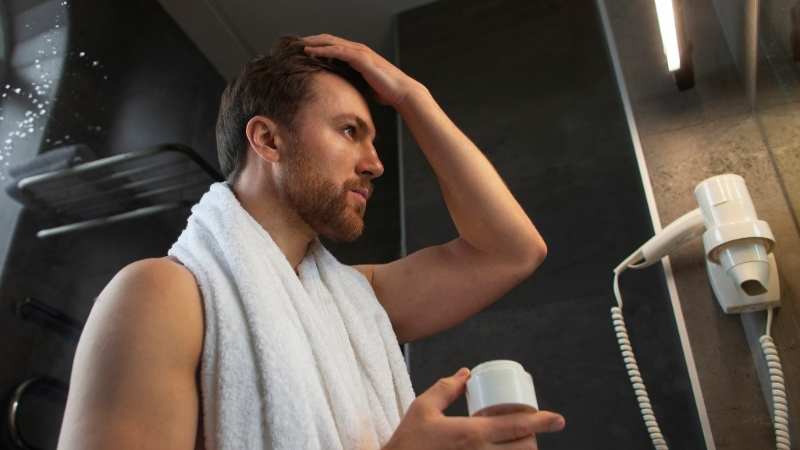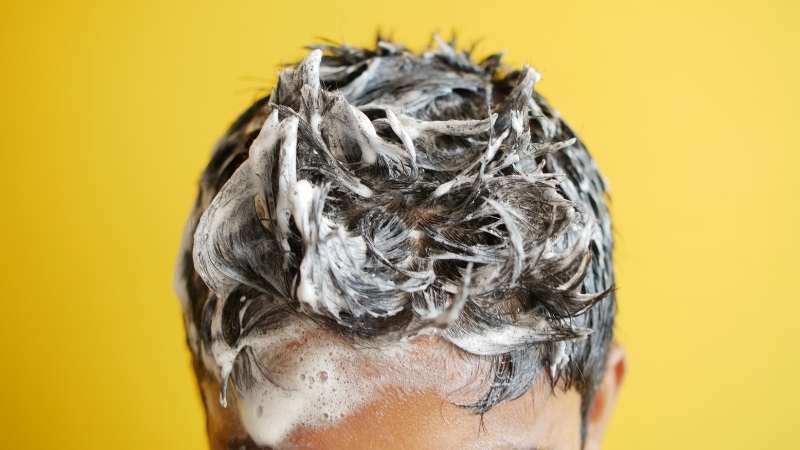Washing hair after hair transplant: Washing your hair regularly plays a crucial role in maintaining the health of your hair and scalp. This doesn’t change after you’ve undergone a hair transplant procedure. In fact, it becomes even more critical to stick to your hair-washing routine to preserve the well-being of your hair.
However, it’s essential to note that employing improper techniques and products for hair washing after hair transplant can potentially harm your newly grafted hairs. Excessive vigor can lead to graft dislodgement or unnecessary scarring. The use of an unsuitable shampoo may also increase the risk of hair transplant infection, along with other potential complications and side effects.
Discover the correct way to wash your hair after a hair transplant to provide your new hair with the best opportunity for healthy growth.
The First Wash After Hair Transplant
Reputable hair transplant clinics typically offer the option for patients to return to the clinic for their initial hair wash following the transplant surgery. During this visit, your clinician will demonstrate the proper hair-washing techniques to use at home. Additionally, they will assess the healing process of your transplant and make any necessary adjustments to your medication if they detect any indications of infection, folliculitis, or other complications.
Here at the Kardelen Clinic, we extend an invitation to all our hair transplant patients to return for a follow-up appointment three days after their procedure. This appointment serves to facilitate a thorough hair wash and to monitor the progress of their healing. And we give you special shampoo for hair transplant.
How to Washing Hair After Hair Transplant?

The utmost consideration when washing your hair after a transplant is to handle it with extreme gentleness. The risk of displacing newly transplanted grafts, particularly in the initial days post-surgery, is high.
Here’s a step-by-step guide for head wash after hair transplant:
- Approximately 30-45 minutes before washing your hair, apply a moisturizing spray or lotion to your scalp to soften the scabs [1]. This aids in the gentle removal of scabs during the washing process and reduces the likelihood of scarring.
- When shower after hair transplant, avoid placing your head directly under strong shower jets, as this can dislodge the grafts. Use a low-pressure setting or fill cups with water to pour over your head.
- Your clinic should provide you with a special antibacterial shampoo designed to prevent infection. If not, you can also use a saline solution (a mixture of salt and water) to maintain the cleanliness of your transplant.
- While first hair wash after hair transplant, using your palms or fingertips, gently massage the shampoo after hair transplant or saline solution into your scalp. Avoid using your fingernails, as they can lift, scratch, or displace hair grafts.
- Rinse your hair, ensuring you use a low-pressure setting during the shower.
- Ideally, allow your hair to air dry. If necessary, you can gently comb it at this stage. If you need to expedite the drying process, use an extremely soft towel or absorbent paper towels (such as kitchen roll) to pat your hair dry. Never vigorously rub your hair or use a hairdryer after a hair transplant. Avoid rough towels as they can catch on hair grafts and dislodge them.
How Frequently Should You Wash Your Hair Following a Hair Transplant?
For the initial 10-14 days following your hair transplant procedure, it is advisable to maintain a daily hair-washing routine, starting with the first wash conducted at the clinic. Daily washing serves the purpose of eliminating any dried blood and scabs from the transplanted area, ensuring its cleanliness and health, while also contributing to making your hair transplant less conspicuous.
Utilizing a safe hair-washing method can also act as a preventive measure against complications like cicatricial scarring [2], which is an inflammatory condition that can harm your hair follicles and potentially result in permanent hair loss.
Beyond the 14-day mark, your scabs should have naturally disappeared, and the transplanted hair roots should have firmly settled into their new positions. At this juncture, you can revert to washing your hair as you normally would using standard hair products, akin to your routine before undergoing a hair transplant.
It’s crucial to emphasize that refraining from washing your hair may lead to hair loss, underscoring the importance of maintaining a frequent hair-washing regimen, particularly when you have a healthy head of hair, to preserve its vitality and shine.
Should You Use Caffeine Shampoo After a Hair Transplant?

Caffeine shampoo has demonstrated nearly equal effectiveness as Minoxidil in promoting hair growth [3]. Therefore, it can be a valuable method to minimize ongoing hair loss and stimulate growth in your transplanted hairs.
However, it is advisable not to start using caffeine shampoo until at least 14 days after your hair restoration procedure. Until that time, it’s recommended to use the after hair transplant shampoo suggested or provided by your surgeon.
How To Manage Post-Transplant Itching
An itchy scalp is a common side effect following a hair transplantation procedure, affecting both the donor area and recipient sites. Nonetheless, scratching your scalp poses a significant risk of dislodging your hair grafts, potentially jeopardizing the success of your hair transplant.
To alleviate scalp itchiness, washing your hair can be helpful, but it’s crucial not to succumb to the temptation of scratching your head while doing so [2]. Minimize this risk by maintaining short nails, taking antihistamines, and applying a saline solution to your scalp.
When Can I sleep Normally After Hair Transplant?
Sleeping positions after a hair transplant should be adjusted to protect the newly transplanted grafts during the initial healing phase, which typically lasts for about 7-10 days. Here are some guidelines for when you can return to sleeping normally:
- First 3-5 Days: During this period, it’s crucial to avoid sleeping on your stomach or directly on the side of your head where the grafts were placed. You should sleep with your head elevated at a 45-degree angle or use a neck pillow to keep your head elevated and reduce pressure on the grafts.
- After 7-10 Days: After the initial healing phase, you can gradually transition back to your normal sleeping positions. However, it’s still a good idea to be gentle and avoid putting excessive pressure on the transplant area for a few more weeks.
- Long-Term Considerations: While you can return to your usual sleeping positions after the initial healing period, it’s advisable to avoid lying on your head for prolonged periods, especially if you sleep with your head pressed against a hard surface. Continued care and gentleness can help protect the transplanted hair during the early stages of growth.
Additional Hair Transplant Aftercare Advice
Diligent care during the hair transplant recovery period is essential for ensuring the success of your procedure. Accidental contact with your grafts during activities such as hair washing or other daily routines can significantly diminish the likelihood of a successful hair transplant.
To optimize the growth potential of your hair transplant, here are additional steps to safeguard the well-being of your grafts:
- Adhere closely to your surgeon’s post-operative instructions.
- Take any prescribed medications as directed.
- Refrain from strenuous exercise for at least one month following FUE or FUT procedures.
- Allocate at least 1-2 weeks for recovery, and consider working from home during this period.
- Shield your head from direct sunlight exposure.
What to Do If You Notice Hair Loss in The Shower?
Witnessing substantial hair loss while washing your hair is often one of the initial indicators of hair loss. It can be a source of concern, particularly when the cause is unclear.
If you observe hair loss in the shower following a hair transplant, this may be an anticipated side effect, such as post-transplant shock hair loss. Alternatively, it could be a transient condition known as telogen effluvium, which can manifest as a consequence of hair transplant surgery. Post-transplant shock hair loss typically occurs 1-2 weeks after the procedure, while telogen effluvium typically emerges 2-3 months later. Both conditions are temporary and usually resolve on their own.
If you have concerns that you might be experiencing any form of hair loss, including male pattern baldness or female pattern hair loss, do not hesitate to reach out to the Kardelen Clinic team. We can assess your hair loss and assist you in devising an appropriate treatment plan to rejuvenate your hair.
Sources:
1- Intechopen
2- National Library of Medicine
3- National Library of Medicine
Frequently Asked Questions
How important is washing hair after hair transplant?
Daily shampooing is necessary to eliminate scabs. After approximately 7-10 days, there should be no remaining signs of dried blood or scabs on your scalp. You can resume your regular hair-washing routine no earlier than 14 days following the transplant. If necessary, you can also wash your hair more than once a day post-operation.
What happens if you don’t washing hair after hair transplant?
If you don’t wash your hair after a hair transplant, it can lead to several potential complications and suboptimal results, including:
Infection: Failing to keep the transplant area clean can increase the risk of infection. The scalp is more vulnerable during the initial healing period, and maintaining proper hygiene is essential to prevent bacterial or fungal infections.
Scab Build-Up: Without regular washing, scabs and dried blood can accumulate on the scalp. This can interfere with the healing process and hinder the growth of newly transplanted hair.
Itching and Discomfort: Post-transplant itching is common, and not washing your hair can exacerbate this discomfort. Scratching the itchy scalp can damage grafts or lead to complications.
Poor Graft Survival: Adequate cleaning is necessary to provide the best environment for graft survival and growth. Neglecting to wash your hair can compromise the success of the transplant.
Delayed Healing: Proper hair washing promotes healing by maintaining a clean and healthy scalp. Delayed healing can extend the recovery period and affect the final results.
Can I wash my hair the day after hair transplant?
No, it is typically not advisable to wash your hair the day immediately following a hair transplant procedure. The immediate post-operative period is a crucial time for the transplanted grafts to settle and heal. Washing your hair too soon can disrupt the grafts and increase the risk of complications.
Most surgeons recommend waiting at least 24 to 48 hours after the hair transplant before attempting to wash your hair. During this initial healing phase, it’s important to follow your surgeon’s specific post-operative instructions, as they may have personalized recommendations based on your procedure and individual circumstances.
It’s crucial to be patient and allow the grafts to stabilize before resuming your regular hair-washing routine. Your surgeon will provide you with detailed guidelines on when and how to wash your hair safely and effectively during the post-transplant recovery period.
Are grafts secure after 7 days?
Grafts are generally more secure after 7 days, but it’s essential to handle them with care throughout the entire post-transplant healing process. After about 7 days, the grafts have typically settled in their new positions and are less prone to displacement. However, they are not fully anchored until they have undergone complete healing, which can take several weeks to months.
When to wash hair normally after hair transplant?
Here’s a general timeline for transitioning to normal hair washing after hair transplant:
Days 1-14: During the first 14 days, you should follow a gentle and specialized hair-washing routine as recommended by your surgeon. This involves using a mild, prescribed shampoo or saline solution and avoiding any harsh rubbing or scratching of the scalp.
After 14 Days: Once the initial healing phase is over and your surgeon gives you the green light, you can gradually transition back to your regular hair-washing routine. You can use your usual hair products and follow your typical washing techniques. However, continue to be gentle when massaging and washing your hair, especially in the transplant area.
Long-Term Care: Even after the initial 14-day period, it’s a good practice to treat your hair gently to protect the transplanted grafts. Avoid vigorous rubbing, harsh hair treatments, and exposure to excessive heat (e.g., very hot water, hairdryers) for several weeks to months to ensure the best outcome from your hair transplant.
When can you brush your hair after hair transplant?
Although you should exercise extreme gentleness during the initial week following hair transplant surgery, you can return to your regular shampooing, brushing, and hair care routines after ten days. By this point, the grafts are securely anchored in place.
How to wash transplanted hair after 10 days?
After 10 days following a hair transplant, you can begin washing your transplanted hair more normally while still taking care to be gentle. Here’s a step-by-step guide on how to wash transplanted hair after the initial 10 days:
Prepare: Gather the necessary items, including a mild shampoo (preferably one recommended by your surgeon), lukewarm water, and a clean, soft towel.
Wet Your Hair: Gently wet your hair with lukewarm water. Avoid using hot water, as it can be harsh on the scalp.
Apply Shampoo: Pour a small amount of the recommended shampoo into your palm. Dilute it with water to create a mild solution, if necessary. Avoid using excessive force when pouring the shampoo.
Massage Gently: Using your fingertips, apply the diluted shampoo to your scalp and the transplanted area. Massage with very gentle circular motions, being careful not to use your nails or apply too much pressure. This helps cleanse the scalp and remove any oil or debris.
Rinse Thoroughly: Rinse your hair and scalp thoroughly with lukewarm water. Ensure that all shampoo residues are completely washed away.
Pat Dry: After rinsing, use a clean, soft towel to pat your hair and scalp dry. Avoid rubbing or vigorous drying, as this can dislodge grafts.
Air Dry: Ideally, allow your hair to air dry. If you need to use a hairdryer, ensure it’s on the lowest, coolest setting, and maintain a safe distance from your scalp to prevent damage.
Comb Gently: Once your hair is dry, you can gently comb or style it. Use a wide-toothed comb or a special post-transplant comb provided by your surgeon.
Follow Surgeon’s Instructions: Continue to follow any specific post-operative care instructions provided by your surgeon, as their recommendations may vary based on your individual case.






